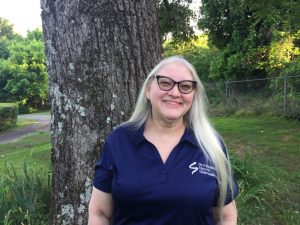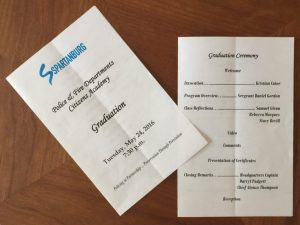Learn about police work at Spartanburg Citizens Academy

As seen on LivingUpstate.com
This week is National Police Week, the perfect time to learn more about police work in our local community.
In 2016, I had the honor of attending the Spartanburg Police and Spartanburg Fire Citizens’ Academy. The first night of class I looked around the room and realized that I was old enough to be the mother of my classmates. For a moment I wondered, “What have I gotten myself into?”
Each of us responded to a question to tell why we had decided to attend. Most of the class members were there because they were considering a career in Law Enforcement. My reason for being there was simple. I wanted to learn more about our local law enforcement and to be a more informed and involved citizen.
We were told on the first night that the 12 weeks would pass quickly. They most certainly did. Primarily because we didn’t just learn, we participated. The first week we were introduced to the department’s “commitment to developing trusting and interactive relationships with the community.” This is an important part of fostering mutual respect and understanding. It includes a dedication to values such as integrity, respect, pride and loyalty. We learned about the history of the Citizens Academy which started in England in 1977 and were introduced to the history of policing going back to the 1600s.
During week two we received an overview of the Police Department, Police Administration Rules of Conduct and Oath of Office. Week three included information about Professional Standards and Inspections and Recruitment/Selection/Hiring.
 Hiring process
Hiring process
I was impressed by the rigorousness of the police and fire hiring process. After an application is submitted there are six different process with many steps to complete before successfully becoming an employee of the City of Spartanburg. I remember thinking that someone must be passionate about their desire to serve. The process includes background investigations, a written test, psychological examination and much more. I take comfort in knowing that our officers are thoroughly screened and well-trained.
K-9 unit and ride-along
During one session we had the opportunity to watch a K-9 in action. These four-legged officers receive daily training; they learn to “apprehend, not maul.” No, I did not volunteer to wear a training suit to learn first-hand what it would feel like to be brought down by a police dog. I did, however, spend an evening shift in a ride-along. It was a pretty exciting night. We met other officers at a call with a potential firearm, stopped at a scene of an accident, checked on a robbery at a local pharmacy, and responded to a call from a female in fear of her boyfriend. I regret that I did not make the time to take part in more than one ride-along.
Personal safety tips
Personal safety was a topic for one of our sessions. We heard the following tips to decrease the probability of becoming a victim: increase your situational awareness; stay alert; walk with confidence, shoulders back; scan your surroundings, make eye contact and acknowledge through speaking. At home: keep your doors and windows locked; close your blinds after dark; never leave keys outside in obvious places; and know your neighbors. Vehicle safety: check your rear seat and mirrors; scan the area; know your route and do not pick up hitchhikers.
Criminal Investigations and Forensics week was very interesting. We had the opportunity to visit the forensics lab and observe some of the techniques used. I appreciate the opportunity to observe the passion and dedication the officers put forth to solve crimes.
911 Communications Center
As part of the program we received an overview of the Fire Division and had an opportunity to visit the Emergency 911 Communications Center. The energy in the room was palpable. I felt a bit overwhelmed as I watched the responders interacting with each other and with the amazing technology as they skillfully handled life or death calls. The Fire Department presentation included a tour with a hands-on opportunity with some of the specialized tools. Fire prevention tips and the opportunity to view the city from a 100-foot platform were other highlights from our visit to the Fire Station.
The following week we were introduced to the Spartanburg Police Technical Support, Records, GIS and Evidence, which included a tour of the evidence room! One week the topic was Traffic, Radar and Driving. We had the opportunity to drive an actual Police Department cruiser with an instructor on a closed course! The term “white-knuckled” comes to mind as I recall this experience.
Slow Down and Move Over
Seeing police vehicles with radar, I have heard comments like, “They must need to meet a quota.” We learned that there are no quotas, and that a very small percentage of revenue from tickets stays in the city. Officers are monitoring to keep our roads safe. Often citations are written for educational purposes because drivers are not always aware of traffic laws. For instance, a South Carolina law implemented in 2002 (Slow Down and Move Over) requires drivers to move to the non-adjacent lane when passing emergency vehicles (police, firefighters, paramedics, tow truck drivers) that are stopped on the roadside with emergency lights flashing, or slow down if moving over is not an option. Many don’t know that this law exists and that they may receive a ticket with a fine and the possibility of points being added to their driving record. In South Carolina. This violation is a misdemeanor offence and requires a fine of $300 to $500.
An officer never knows what will occur when they approach a vehicle. I use a simple practice to show that I respect the officer and their desire to return home safe after their shift. I keep my license and registration within easy reach so that I can have them on my dashboard. Before the officer approaches my car, I have my window down and my hands palm down with my fingers open and resting on the steering wheel. Captain Tim Suber, of the Spartanburg Police Department, advices drivers to “turn on the interior light of your vehicle if you are pulled over at night.”
 What I have described so far is a comprehensive program but there was more to come. We learned about the Spartanburg Judicial System and the Narcotics Unit. On the evening of our graduation, we were able to witness the Tactical Unit in action.
What I have described so far is a comprehensive program but there was more to come. We learned about the Spartanburg Judicial System and the Narcotics Unit. On the evening of our graduation, we were able to witness the Tactical Unit in action.
This program gave me a deep appreciation for all Law Enforcement personnel. Realizing how high the stress levels are is part of the reason I became a HeartMath® Certified Coach. HeartMath® is used by Police Departments around the world to help build and sustain physical, emotional and mental resilience. This is important because the challenges of being an officer can take a serious toll on health and well-being. HeartMath® training and mentoring offers evidence-based programs that lead to improvements such as: better sleep, ability to maintain composure in challenging environments, quick judgment and adaptive thinking, and capacity to reset after tough experiences.
To learn more, visit City of Spartanburg Citizens Academy.
About the Author
Stacey Bevill, ACC, NCC, MPM®, is the founder of Ask and Receive Coaching, LLC which offers coaching, consulting, custom workshops, and presentations. She received her certification from the internationally acclaimed Newfield Network Coaching Institute. She is certified by the International Coach Federation (ICF) and the International Association of Trauma Professionals (CTP). Stacey also is a Certified HeartMath® Coach. She and her husband reside in Spartanburg, SC.
